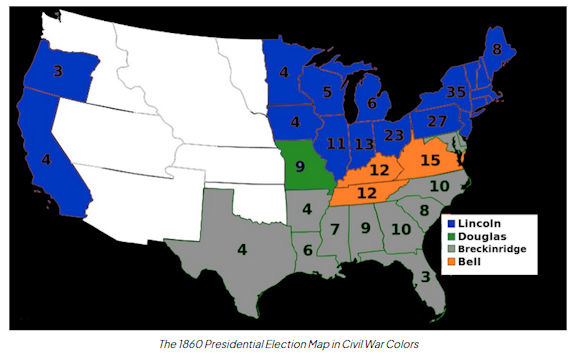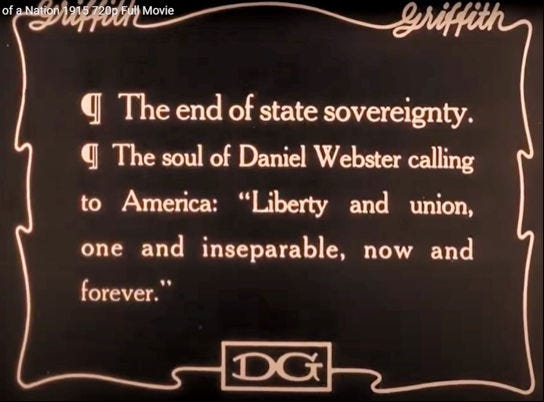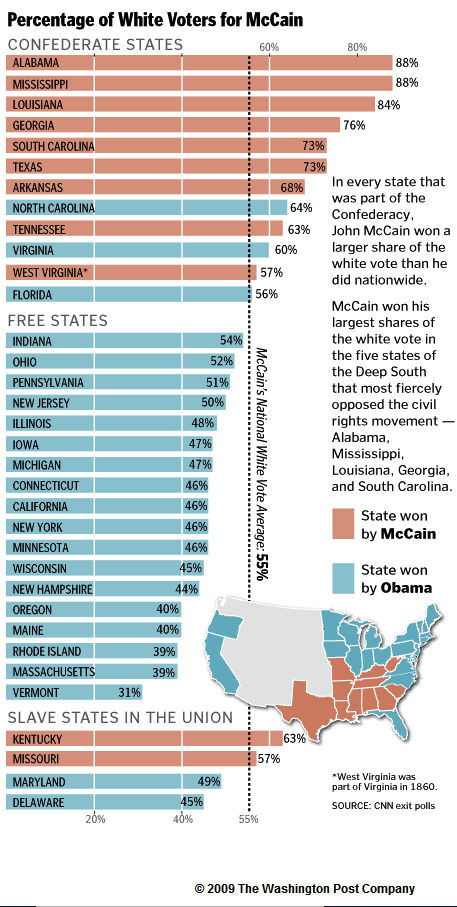NOTE: A shorter version of this essay was first published on ResoluteSquare.com
The time has come to change the standardized color designations of the major American political parties. The prevailing colors are arbitrary and meaningless. An alternative color coding, one that is historically accurate, is available. We should use it.
When John Chancellor of NBC began a political color scheme on television studio presidential electoral maps in 1976, as a 2012 Smithsonian Magazine article puts it, blue was red and red was blue. Viewed through today’s color lens, a map of the 1980 election appears to show that Jimmy Carter defeated Ronald Reagan in a landslide.
A similar reversal has happened over a longer period with the two major parties. In the 1850s and 60s, the party that defended the United States and the principles on which the nation was founded was called “Republican” and the party that opposed those principles and sought to tear the nation apart was called “Democratic.” Today, those names are reversed.
The convention of red = Republican; blue = Democratic became entrenched during the disputed Election of 2000. New York Times graphics editor Archie Tse told The Verge in 2012 that the reasoning was “red begins with r, Republican begins with r, it was a more natural association.” Perhaps so in terms of the alphabet, but the use of red for a party that, going back at least to Richard Nixon and Joe McCarthy in the 1940s and 50s, railed against “Reds” (Communists) seemed odd. It still does.
_____
As many Americans fear a new civil war and Donald Trump riles up his followers, those around him, such as Peter Navarro, promote the threat, and MAGA extremists in Congress call for the use of force, as Matt Gaetz did recently, and Trump himself suggests (among many similar remarks about others) that retiring Joint Chiefs of Staff Chairman Gen. Mark Milley should be executed—“in times gone by, the punishment would have been DEATH”—and “Republicans” don’t say anything in response, applying the colors of the opposing sides in the Enslavers’ Rebellion (aka Civil War), would both be more accurate and make the stakes of the current threat the MAGA movement poses to the United States more readily understood.
It is appropriate that blue has become the color associated with the Democratic Party. It was the color of the uniforms worn by those fighting to preserve the United States in the 1860s. At that time, they were called Republicans, and blue would be sensible to designate states won by Republicans, with gray denoting Democratic states, as is shown in the 1860 electoral map below. (The Democratic Party split in 1860, between Stephen A. Douglas of Illinois, who carried only Missouri, and Southern Democrat John C. Breckinridge of Kentucky. The short-lived Constitutional Union Party ran John Bell of Tennessee, who won his home state along with Virginia and Kentucky. Breckinridge won all the other slave states. Abraham Lincoln won all the non-slave states.) With the positions of the two major parties now reversed, the fitting color to represent the “Republican” Party is not red but gray, the color of the uniforms worn by those who rebelled against the United States in the 1860s.
If you think that is hyperbolic, consider that what once proudly called itself the Party of Lincoln is now headed by a man who says insurrectionists who attacked the Republic at its most fundamental level, the peaceful transfer of power after an election, and invaded the United States Capitol carrying a Confederate battle flag and seeking to hang the Vice President and murder the Speaker of the House are heroes and patriots whom he will pardon if he regains power.
“Republicans” are assaulting the rule of law and all the basic institutions of a republic. Trump is promising that if he regains the presidency, he will commandeer all power under himself. Texas Gov. Greg Abbott is asserting that his state has “sovereign authority,” a matter that was settled the other way by the Civil War, as even D.W. Griffith’s outrageously racist 1915 film, Birth of a Nation, recognized with a title card that identified Robert E. Lee’s surrender at Appomattox reading, “the end of state sovereignty.”
The Confederacy was explicitly based on opposition to the ideals put forth in the Declaration of Independence. John C. Calhoun, the leading theoretician of the beliefs that underpinned the rebellion of 1861, labelled slavery “a positive good” and demanded “minority [the minority, of course, being the wealthy, especially enslavers] veto power … to restrict what voters can achieve together in a democracy to what the wealthiest among them would agree to.”
In his 1861 “Cornerstone Speech,” Confederate Vice President Alexander H. Stephens proclaimed that the Declaration’s belief in human equality is “fundamentally wrong.” The Confederacy directly rejected the 1776 definition of an America based on democracy and insisted that governments do not “derive their just powers from the consent of the governed.”
The Confederacy was all about inequality, hierarchy, domination by some and subordination of others. In all these regards, today’s “Republican” Party has taken up the positions of the Democrats of the mid-nineteenth century. “Trump discarded the idea of equality before the law,” as Heather Cox Richardson says in her new book, Democracy Awakening, “and scoffed at the notion that Americans had the right to choose their government.” In doing so, he and those who have joined him “embraced the false past of the Confederates.” They are fully committed to what Calhoun, Stephens, et. al. believed: opposition to democracy and to government by the consent of the governed, because, as red-state—make that gray-state—referenda on such issues as women’s control of their bodies and Medicaid expansion keep demonstrating, they lose when people vote.
Much as the wealthy enslavers used race—a floor beneath which white people could not fall—to bring along poor folks to fight and die for the interests of those above them, the MAGA movement has exploited the insecurities of lower-income whites to get them to do the bidding of the superrich. Their instruction goes something like this:
Look for the causes of your problems below you, not above; we’ll keep Others—people of color and women—beneath you. Democracy gives Them power; an authoritarian Leader will protect you.
Today, blue and gray are more states of mind than of geography, yet in 2008 the first African American major party presidential candidate carried every state that Abraham Lincoln had won 148 years earlier, and a compilation I did for the Washington Post after the 2008 election found that in every state that had been part of the Confederacy Barack Obama’s Republican opponent, John McCain, won a larger percentage of the white vote than his nationwide average. And, in 2020, Trump carried every state that had been part of the Confederacy except Virginia and Georgia and he won two (Kentucky and Missouri) of the four slave states that did not secede. President Biden won in 2020 all the free states of 1860 except Ohio, Indiana, and Iowa:
If Trump and his devoted following wore gray MAGA hats, they wouldn’t stand out so much, but the color of the Confederate traitors would reflect the movement’s intentions far more truthfully than a hue associated with Communists does.
Apart from a protracted dispute over the outcome of the Election of 1876 that ended in a compromise, the only past time that a major fraction of a political party flatly refused to accept the result of an American election was 1860 and it produced an internal war that killed more Americans than died in all other wars the country has been involved in combined. Reminding people of that truth by using colors that accurately connect today’s parties with that terrible event would be a small step toward assuring that nothing similar happens in our time.
Let’s try it.









